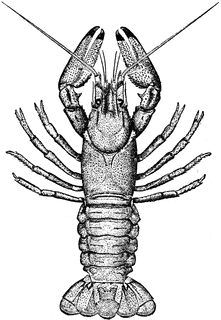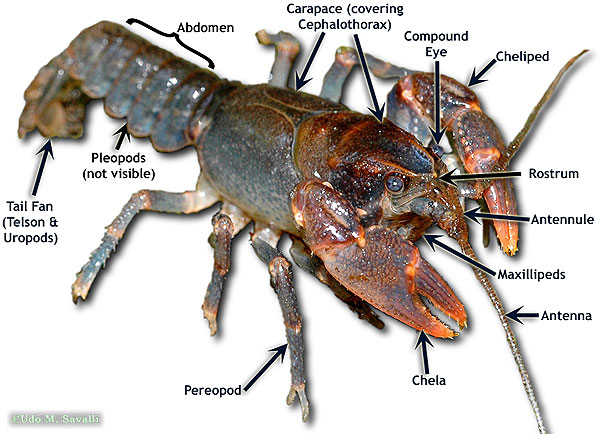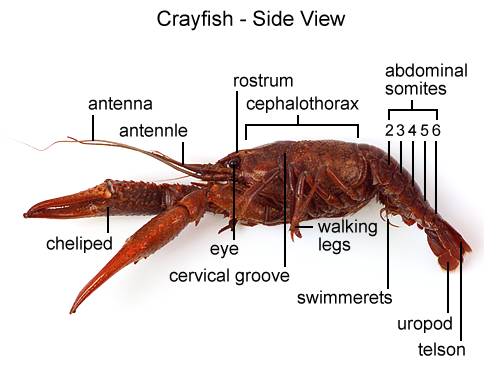41 crayfish labled
Crayfish Anatomy - biologyclermont.info The chelipeds of crayfish are appendages of segment #8, while the chelicerae of scorpions are appendages of segment #1. Note that in both the arachnids and the insects, segment #8 has no appendages at all. In crustaceans, segment #1 bears the antennae, and in insects, has no associated appendages. Classification of Crayfish: Crayfish Dissection - BIOLOGY JUNCTION Procedure Part 1—External Anatomy of a Crayfish 1. Put on safety goggles, gloves, and a lab apron. 2. Place a crayfish on its side in a dissection tray. Use the diagram below to locate the cephalothorax and the abdomen. The carapac e, a shield of chitin, covers the dorsal surface of the cephalothorax.
crayfish | Description, Size, Habitat, Diet, & Facts | Britannica crayfish, also called crawfish or crawdad, any of numerous crustaceans (order Decapoda, phylum Arthropoda) constituting the families Astacidae (Northern Hemisphere), Parastacidae, and Austroastracidae (Southern Hemisphere). They are closely related to the lobster. Over half of the more than 500 species occur in North America. Nearly all live in fresh water, although a few species occur in ...

Crayfish labled
Crayfish: Characteristics, Anatomy & Habitat | Study.com Crayfish are invertebrates which means they don't have a backbone. They are also arthropods, which means that they have a protective exoskeleton on the outside of their body. Other arthropods... Crayfish Dissection - Penn State Altoona Biology 110 Crayfish Dissection Purpose The purpose of this lab activity is to help you learn the anatomy of a crayfish and give you a better understanding of the anatomy of invertebrate animals in general. After completing this dissection, you should be able to: Correctly identify the locations involved in the dissection procedures, and Crayfish Internal Anatomy - Shrimp and Snail Breeder Crayfish have light blue blood. This is because they do not have hemoglobin. Their blood cells use hemocyanin, which gets its blue color from the copper that is part of its structure. To be precise, their so-called "Blood," is a combination of haemocyanin and an interstitial fluid called "hemolymph". Their blood can coagulate very rapidly.
Crayfish labled. Crayfish Labeled Diagram | Quizlet Start studying Crayfish Labeled. Learn vocabulary, terms, and more with flashcards, games, and other study tools. Crayfish Dissection - BIOLOGY JUNCTION Labels should start outside the drawing, and be connected to the structure by arrows with tips (===>). The Tip of the arrow should be touching the structure. Be sure to include the magnification for any drawings done with the dissecting microscope. Hang on to the drawings; they will all be handed in later, together with some questions to answer! Label Crayfish External Diagram Printout - EnchantedLearning.com EnchantedLearning.comLabel Crayfish External Anatomy. Read the definitions below, then label the crayfish diagram. Abdomen - The abdomen is the segmented tail area. The swimmerets, telson, and uropods are attached to the abdomen. Carapace - The protective shell (exoskeleton) of the cephalothorax. Anatomy of a Crayfish (Virtual) - The Biology Corner The crayfish belongs to the Phylum Arthropoda, which includes organisms that have an exoskeleton, jointed appendages and segmented bodies. In fact, the word "arthropoda" means "joint-foot". Crayfish have two main body areas: the cephalothorax, which consists of the head and upper body, and then the abdomen, which is clearly segmented.
Marbled Crayfish Original Website Since 2007. True Clones! This is Procambarus Marmorkrebs "Marbled Crayfish". This is one of the strangest crayfish you will ever find! It is the only crayfish in existence - and one of the only animals known - to TRULY clone itself. Marbled Crayfish do not need a mate to have babies! Here is my original article in world-famous Tropical Fish Hobbyist magazine: Anatomy of the Crayfish | Carolina.com Crayfish are members of the large and diverse animal phylum Arthropoda. It's thought that two-thirds or more of all animals are arthropods. ... Anatomy of the Crayfish. Download PDF. If the PDF does not display below, you may also download it here. Get Teacher Tips and Exclusive Offers. Crayfish - Wikipedia Crayfish are freshwater crustaceans resembling small lobsters (to which they are related). In some locations, they are also known as crawfish, craydids, crawdaddies, crawdads, freshwater lobsters, mountain lobsters, rock lobsters, mudbugs, baybugs or yabbies. Taxonomically, they are members of the superfamilies Astacoidea and Parastacoidea. Marbled crayfish - Wikipedia The marbled crayfish or Marmorkrebs ( Procambarus virginalis) is a parthenogenetic crayfish that was discovered in the pet trade in Germany in 1995. [5] [6] Marbled crayfish are closely related to the "slough crayfish", Procambarus fallax, [4] which is widely distributed across Florida. [7] No natural populations of marbled crayfish are known.
Crayfish Dissection PROCEDURE PART 1: External Anatomy of a Crayfish 1. Place the crayfish on its side in the dissection tray. Use the diagrams above to locate the cephalothorax and the abdomen. The carapace, a shield of chitin, covers the dorsal surface of the cephalothorax. On the carapace, locate the indentation known as the cervical groove . Invasive Species: Marbled Crayfish - Michigan A medium-sized crayfish, ranging from 4 to 5 inches in length. A marbled color pattern most visible on its carapace or back. Coloring is generally olive to dark brown but can range from tan to reddish to blue. Claws are slender or narrow. Marbled crayfish are named for the streaked or marbled appearance of the shell and claws. Crayfish External Anatomy - Shrimp and Snail Breeder Crayfish are characterized by a joined head and chest. That is why biologists usually do not describe this part of the crayfish by itself. Nonetheless, it protects nerve cell clusters (cerebral ganglion or ganglia that can be called as a brain) and digestive gland. The head has 5 pairs of appendages. Such as: The antennules. Long antennae. Crayfish - The Australian Museum Crayfish, like many crustacean have a carapace or shield which projects backwards from the head and covers all of the thorax The carapace has two functions; firstly it protects the delicate feather-like gills which branch off from the base of the legs, and secondly it provides a water channel that is a constant flow of oxygenated water to pass ...
Male Vs Female Crayfish [Differences Illustrated] - Acuario Pets First, look at the claws. These claws are known as Cheliped or 1st walking leg set. After the Claw, there are additional 4 pairs of walking legs. These walking legs are called Pereopods. After the walking legs, on the abdomen of the crayfish, you'll see very small sized legs like walking legs. These are called swimmerets of Pleopods.
PDF Cray˜sh Dissection Guide - VWR International External Anatomy Antenna Cheliped Antennule Rostrum Eye Cervical Groove Carapace Telson Third Maxilliped Walking Legs Swimmerets Uropod Cephalothorax Abdomen
Crayfish Internal Anatomy - Shrimp and Snail Breeder Crayfish have light blue blood. This is because they do not have hemoglobin. Their blood cells use hemocyanin, which gets its blue color from the copper that is part of its structure. To be precise, their so-called "Blood," is a combination of haemocyanin and an interstitial fluid called "hemolymph". Their blood can coagulate very rapidly.
Crayfish Dissection - Penn State Altoona Biology 110 Crayfish Dissection Purpose The purpose of this lab activity is to help you learn the anatomy of a crayfish and give you a better understanding of the anatomy of invertebrate animals in general. After completing this dissection, you should be able to: Correctly identify the locations involved in the dissection procedures, and
Crayfish: Characteristics, Anatomy & Habitat | Study.com Crayfish are invertebrates which means they don't have a backbone. They are also arthropods, which means that they have a protective exoskeleton on the outside of their body. Other arthropods...





























Post a Comment for "41 crayfish labled"